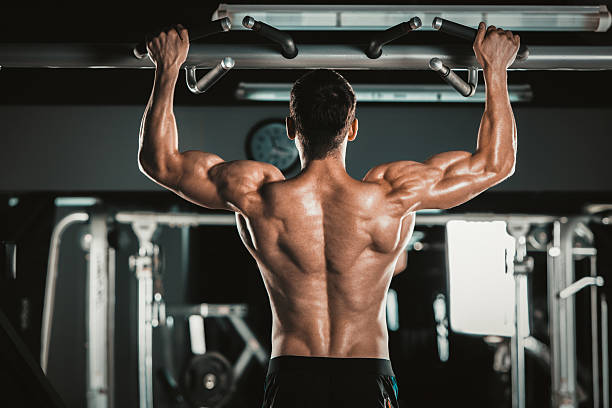Because they can’t connect their minds and muscles to the target muscle and can’t contract it with every rep, many people find it particularly challenging to engage the lower lats.
You should perform lower lat-specific exercises to build this muscle group. This article lists the top five lower lat moves for developing a broad and dense back.
What Are Lower Lats?
Taking up the majority of the lower posterior thorax, the latissimus dorsi is a fan-shaped, flat, broad muscle. The trapezius on the back, close to the midline, partially covers it, and it extends to the sides and behind the arm.
When we speak of the lower lats, we mean the collection of fibers that enter the lower third and fourth ribs, where they interdigitate with the external oblique muscle, inferior angle of the scapula, and iliac crest of the hip bone.
It should be noted that when exercising, the lower lats cannot be completely isolated. The same location on the upper arm serves as the insertion point for all latissimus dorsi muscle fibers, which explains this. Therefore, when you perform a lat exercise, all lat fibers are engaged. But by changing your exercise form and training approach, you can more effectively activate the lower part of the lats.
How to Target Your Lower Lats
Underhand Grip
Most back exercises involve an overhand grip. Your palms should be facing downward while performing an exercise in this pronated hand position.
However, for a few reasons, using an underhand grip can make it simpler to contract your lower lats.
The reverse grip first requires that you keep your elbows close to your sides. And second, using an underhand grip typically causes you to shift the weight closer to your hips.
Elbows In
Your elbows flare out and your arm rotates externally when performing exercises like wide-grip lat pulldowns. The shoulders and upper back muscles are used in this external rotation.
In contrast, exercises like a narrow grip row require you to keep your elbows close to your body and rotate your arms inward. As a result of the internal rotation, the upper back is not as heavily loaded.
You can verify this by feeling your back with one hand while performing each of these exercises with the other arm.
Pull to Hips
Last but not least, when performing back exercises, pull the weight towards your hips rather than your stomach or chest. This guidance is especially useful for cable or free-weight rowing exercises.

Best Lower Lat Exercises
Lat Pull-In
The unilateral Lat Pull-In is an improvement on the Lat Pull-Down in that it better engages the lower lats. Exercises that involve only one side are excellent for correcting muscle imbalances and developing a mind-muscle connection.
Step-by-Step Guide:
1. A cable pulley machine should be positioned in front of a bench with the highest setting.
2. Sit down with your right side facing the pulley machine and grasp the handle with your right hand.
3. With your hip in mind, pull the cable down and in.
4. Touch your elbow to your hip bone to complete a full lower-back contraction.
5. In this position, contract the lower lats.
6. Return to the starting position slowly, letting the lats fully extend.
7. Repeat for reps before switching sides。
Dumbbell Row to Hips
A different type of single-arm row is the dumbbell row to the hips. The best way to better target the lower lats is to change the direction of your upward pull. You should pull back in an arc-like motion instead of rowing the dumbbell up.
Similar to the previous exercise, the dumbbell should start under your shoulder and end at your hip. This makes it possible to fully contract the lower lats.
Step-by-Step Guide:
1. Holding a dumbbell in your right hand, take a position next to a bench. Step your left leg back in a staggered stance and support yourself by placing your left hand on the bench. Your torso ought to be at a 45-degree angle in this position.
2. Row the weight up and back to touch your hip while the dumbbell is hanging directly below your shoulder. When rowing, keep your chest up and your shoulders down. Take a moment to hold the contraction.
3. Repeat until you have completed the necessary number of reps, then slowly return to your starting position.
Seated Band Row
An alternative to the cable seated row that doesn’t limit you to the machine’s predetermined path is the seated band row. Although you won’t be able to apply as much resistance when using the band, your lats will already be pre-exhausted if you include this exercise third in your routine after the two previously mentioned.
Your lats are continuously tense when you perform the seated row with a band. Make sure to externally rotate your shoulders with your scapula slightly depressed and your chest raised to keep the focus on your lower lats. Instead of using your trapezius muscles during the exercise, try using your lower lats.
Step-by-Step Guide:
1. With your legs outstretched, sit down on the floor. Wrap a resistance band in a loop around your mid-foot while maintaining a neutral grip on the other end. Your hands in this position should be at knee height. Keep your spine neutral and your torso upright.
2. When your hands are at hip level, row your arms back while keeping your elbows tucked in at your sides. Hold while tightening the lower lats for a brief period of time.
3. Return slowly to the starting position and carry on for the required number of reps.

Straight-Arm Lat Pulldown
Your lats will be stretched out in the starting position and will be fully contracted in the lower position after performing a straight-arm lat pull-down. Squeezing your lower lats while maintaining the bottom position for a two- to three-second count is essential for working them.
Step-by-Step Guide:
1. Place a short handlebar on the cable and adjust the cable pulley to the highest position.
2. Take an overhand grip on the handle with both hands.
3. To position your arms at a 45-degree angle with the floor, take a few steps back. Keep your arms straight throughout the motion and lean your upper body forward slightly.
4. Pull the bar into your hips while maintaining a downward shoulder position and a slight scapular depression. As you tighten your lower lats, maintain the bottom position for two to three seconds.
5. Take your time getting back to where you were. Repeat until the necessary number of reps has been completed.
Underhanded Bent-Over Barbell Row
The underhanded bent-over barbell row is a variation of the standard barbell bent-over row in which your hand position is switched. As a result, the lower lats are better engaged because you can depress your scapula and maintain a low shoulder position.
Compared to the typical barbell bent-over row, this exercise also emphasizes the biceps more.
Step-by-Step Guide:
1. Put a loaded barbell on the ground in front of you. Stand with your feet hip-width apart.
2. Using a shoulder-wide underhand grip, reach down and hinge at the hips to grab the bar.
3. As you row the bar up to your ribs, depress your shoulders and tighten the muscles between your shoulder blades. Hold the top position for a brief moment before tightening the lower lats.
4. Repeat this motion until the required number of reps has been completed by lowering the bar until your arms are fully extended.
The Benefits of Training Your Lats
Almost every lifter who enters the gym aspires to have the broad shoulders and V-shaped torso that they admire. You must work your lats hard and frequently to achieve this look, as well as maintain a healthy diet to help you lose weight.
Even though they are not trained directly, the lats are essential for the big three (the bench press, squat, and deadlift). The lats are activated during squatting (by pulling the barbell into your upper back) and maintain your upright posture, preventing your squat from turning into a good morning.
Strong lats help you maintain a neutral spine when deadlifting and keep the bar close to you as you pull. The greater your distance from the bar during the pull, the greater your risk of rounding your spine is.
Engaged lats aid in an effective pressing path and provide a stable base to press from during the bench press. Furthermore, your lats help you transfer force from your leg drive to your chest.
Summary: Exercise Regularly
Even though you can’t completely isolate the lower lats, you can concentrate on them by performing the right exercises in the right ways. You can engage and contract the lower lats with the help of the five exercises described in this article. For best results, do this exercise twice weekly.
